2 南京雨后地软环境技术有限公司, 江苏 南京 210013;
3 中国科学院西北生态环境资源研究院, 沙漠与沙漠化重点实验室, 甘肃 兰州 730000;
4 南京市环境卫生保障应急处置中心, 江苏 南京 210000;
5 浙江师范大学化学与生命科学学院, 浙江 金华 321004;
6 国防科技大学气象海洋学院, 江苏 南京 211101;
7 南京师范大学 地理科学学院, 虚拟地理环境教育部重点实验室, 江苏 南京 210023)
淡水资源一直与人类生存息息相关,而夏季风降水又是全球淡水的重要补给之一,特别是北半球夏季风降水,其不仅是全球季风系统的重要组成部分,也影响了北半球大部分沿海地区的经济发展。然而,在不同时间尺度上的气候变化特征及其影响机制并不相同[1]。研究不同时间尺度上的气候变化特征,不仅有利于深入理解气候系统演变规律,也可为各国经济政策的制定提供有利依据。因此,探讨不同时间尺度上北半球夏季风降水的变化特征及其影响机制,在关系着人类经济可持续发展的同时,对深入了解海气相互作用的动力机制提供参考依据。
近十几年来,将全球季风作为一个系统进行研究已取得了长足进步,如利用不同气候要素(风速[2]、亮温[3~4]和降水[5]等气候指标)来定义全球季风的范围和强度,对深刻认识季风系统的发展提供了重要理论基础。基于此也探讨了在不同时间尺度上全球季风系统的演变过程。在年际尺度上,全球夏季风降水与热带太平洋海表面温度(Sea Surface Temperature,简称SST)有直接关联[5],即厄尔尼诺-南方涛动(El Niño -Southern Oscillation,简称ENSO)的年际周期特征对全球季风降水强度有较大影响[6]。另外,ENSO事件的振幅强度可导致赤道辐合带(Intertropical Convergence Zone,简称ITCZ)位置偏移[7],从而对全球季风系统产生影响[8]。此外,火山活动对季风[9]乃至全球气候[10]都有显著影响,即较大的火山喷发,一方面可以对全球气候产生即时效应[11],即火山喷发物致使全球温度降低,全球季风降水下降;另一方面,不同纬度[12]、季节[13]的火山活动,都可以对热带太平洋SST型态进行调制,从而间接影响全球季风降水强度的变化。由此可见,在年际尺度上,全球夏季风降水分布与ENSO模态关系较为密切。
在年代际尺度上,根据观测资料显示,过去50年来全球夏季风降水表现出微弱的年代际下降趋势[14],而在1970年代末,则表现出了明显的年代际上升趋势[15]。这一年代际转变过程很可能和北太平洋SST的年代际空间分布特征的转变有关,如太平洋年代际振荡(Pacific Decadal Oscillation,简称PDO)[16]和巨型厄尔尼诺-拉尼娜(Mega-ENSO)[17]等。模式资料表明[9],近30年来火山活动的增加,是导致过去50年全球夏季风降水年代际下降趋势的主要原因之一。此外,近几十年来人类活动所排放的气溶胶含量的显著增加,亦对全球季风降水产生直接[18~19]和间接[20]的影响。综上所述,全球夏季风降水在年代际尺度上受外强迫与气候系统的共同作用影响。
要想了解全球季风降水的多年代-百年际时间尺度特征,更长时间跨度的气候资料必不可少。现阶段,过去2000年气候变化的研究方兴未艾,各种区域气候代用资料也日益增多[21~23],国际过去全球变化研究计划(Past Global Changes,简称PAGES)也发起了对全球各个区域过去2000年气候变化的重建工作[24]。但由于气候代用资料未能对一些气候要素场(如风场、气压场等)进行重建,这导致利用重建资料来研究全球季风系统的成因机制较为困难[25]。因此,气候模拟成为研究多年代-百年际全球季风系统成因机制的主要工具之一。以往研究表明[26~27],全球季风降水变化与全球平均温度在多年代-百年际变化趋势上较为一致,具有明显的“暖湿”—“冷干”—“暖湿”的变化特征,对应于过去千年时段的主要特征时期(中世纪暖期、小冰期和现代暖期等),说明过去千年来外强迫因子对全球季风在多年代-百年际演变起主导作用,特别是有效太阳辐射(太阳辐射+火山活动)与过去千年全球季风在多年代-百年际尺度变化上具有较好的相关性,有效太阳辐射引起的海陆温度差异是导致全球季风强度多年代-百年际变化的主要原因之一[28~29]。此外,通过对过去千年特征暖期(中世纪暖期和现代暖期)北半球夏季风降水强度的归因分析发现[30]:在中世纪暖期,北半球夏季风降水强度主要受自然外强迫(太阳辐射与火山活动)的影响;在现代暖期,其变化中可以检测出微弱的人类活动信号(温室气体浓度变化)。从政府间气候变化专门委员会(Intergovernmental Panel on Climate Change,简称IPCC)预设的未来情景下多模式模拟结果可以看出,虽然现阶段温室气体浓度的快速增加对全球季风强度变化的影响较小[14],但当温室气体浓度超过一定阀值时,可抑制气候系统的内部调制作用,成为影响全球/北半球季风降水变化的主导因素[31],使全球热带地区陆地夏季风降水表现为“湿区更湿,干区更干”的特征[29]。另外,北大西洋多年代际涛动(Atlantic Multi-decadal Oscillation,简称AMO)也是引起北半球夏季风强度多年代际变化的主要原因之一[17]。由此可见,在百年际尺度上,外强迫作用已经成为影响全球夏季风变化的主要原因之一。
总之,以往研究虽然探讨了全球/北半球夏季风系统在不同时间尺度上的变化特征和可能原因,但由于模拟资料时间长度的限制,对不同时间尺度上全球/北半球季风系统的周期性和空间变化特征的研究工作较少。为此,本文利用通用地球系统模式CESM进行了长达2000年的瞬变积分模拟试验,并利用模拟结果,以北半球夏季风系统为主,在了解其周期信号的同时,探讨在不同时间尺度下北半球夏季风降水的空间分布特征及其可能影响机制,力图为对全球/北半球夏季风系统的研究做出贡献。
1 模拟试验与方法 1.1 模式简介本研究使用的通用地球系统模式(Community Earth System Model,简称CESM)是由美国国家大气研究中心(National Center for Atmospheric Research,简称NCAR)2010年推出的地球系统模式,是CCSM(Community Climate System Model)的升级版本。CESM广泛应用于对过去[32]、现在[33]和未来气候[34]的模拟试验当中,是当今较为先进的地球系统模式之一[35]。
用于本研究的CESM1.0版本是一个包括海-陆-气-冰的全耦合模式的低分辨率版本,其中大气模式为CAM4(the Community Atmosphere Model version 4),陆面模式为CLM4(the Community Land Model version 4),海洋模式为POP2(Parallel Ocean Program version 2),海冰模式为CICE4(the Sea-Ice Component version 4)。大气和陆面模型在水平方向上采用T31波截断(约3.75°×3.75°)。大气模型的垂直方向采用汇合δ坐标,共分为26层;POP 2模式分为60层,最大深度约为5500 m,其在全球范围内的经向格点为100,纬向为116格点。不同子模式之间通过NCAR开发的耦合器(Coupler 7)进行数据交换。
1.2 试验设计本研究首先利用CESM进行了长达2000年的瞬变积分模拟试验(称为全强迫试验),具体试验设计请参考文献[36~37],这里简单介绍模式所使用的外强迫资料场。用于驱动模型的外强迫条件包括基于国际通用的由Berger[38]提出的方法计算的过去2000年的地球轨道参数序列;根据宇宙放射性同位素重建的过去2000年太阳辐射变化序列[39];利用极地冰芯提取的硫酸盐资料重建的过去1500年火山活动场[40];从南极冰芯提取的代用资料重建的过去2000年温室气体序列[41]以及根据过去千年人口数量变化重建的过去2000年土地利用/土地覆盖的空间分布资料[42]。外强迫资料的时间演变特征如图 1所示。由于进行试验时,未能找到公开发表的过去2000年高分辨率火山活动重建资料,所以本试验结果的1~500年火山气溶胶含量设置为0。为了科学严谨,本研究只截取全强迫试验结果的最后1500年进行分析,即501~2000 A.D.。此外,本次试验选用的太阳辐射序列为现阶段重建结果中振幅较大序列(蒙德极小期与现代比值约为0.4 %),这对研究CESM对不同外强迫因子的敏感性差异具有一定的参考意义。在以往研究中,我们已经利用此结果进行了大量的验证工作,包括CESM长期积分的稳定性,刻画气候系统内部变率的能力,与气候平均态的比较工作[43],与全球[43]及区域过去2000年重建资料的对比工作[44~48]以及对北半球夏季风降水的模拟能力[30]等,较好地验证了模式模拟现代气候及过去千年气候的准确性和可靠性。为避免重复,本文直接引用上述研究成果来证明CESM这套试验结果对研究过去2000年北半球夏季风降水变化的可靠性。
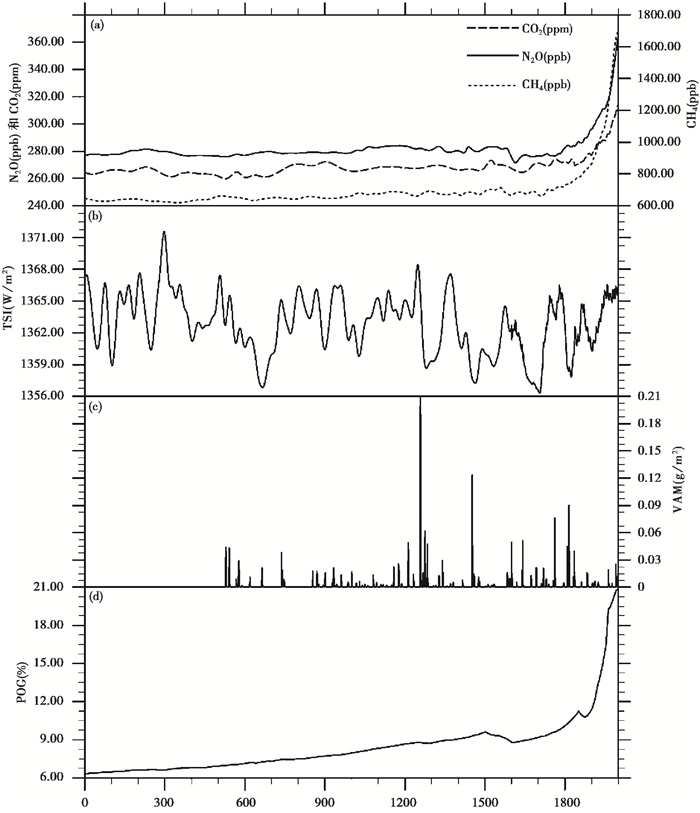
|
图 1 CESM过去2000年模拟的主要外强迫因子 (a)温室气体(浓度变化,单位:ppb和ppm);(b)总太阳辐射(单位:W/m2);(c)火山活动(喷发气溶胶质量变化(VAM),单位:kg/m2);(d)土地利用/土地覆盖(植被类型所占的格点百分比(POG),单位:%) Fig. 1 The reconstructions employed as the main forcing time-series for the CESM experiment over the past 2000 years. (a)Greenhouse gases(GHGs, ppm or ppb); (b)Total solar irradiation(TSI, W/m2); (c)Volcanic forcing(VOL, volcanic aerosol mass, kg/m2); (d)Land use and land cover(LUCC, percent of grid, %) |
研究中对北半球夏季风区域的划定是根据Wang等[5]提出的理论进行定义:在北半球区域,年平均降水量大于2 mm/天,且夏季降水量占全年降水量的55 %以上,其中夏季是指5~9月平均。以往研究表明,CESM在模拟西北太平洋季风区域表现出了明显不足,虽然此区域达不到夏季风定义要求,但是区域降水变幅则较为一致[30],所以并不影响探讨其在过去2000年夏季风降水的变率问题。因此,本研究以观测资料所刻画的北半球夏季风区域为主,定义北半球夏季风指数为北半球夏季风区域内各个格点的降水率之和。前人的研究表明[14, 17, 26~27],北半球夏季风指数在各个时间尺度上都具有一定的代表性,可以用以表征北半球夏季风系统的强度。
为了更好地研究在不同时间尺度下北半球夏季风降水的空间特征,本文利用集合经验模态分解法(Ensemble Empirical Mode Decomposition,简称EEMD)对北半球夏季风指数进行分解,以提取其主要的时间尺度信号。EEMD是一种近年来发展起来的时间上局部的自适应时间序列分析技术,适用于非线性、非平稳时间序列[49]。其核心思想是在原始信号中加入高斯白噪音,使信号在不同时间尺度上具有连续性。此外,由于白噪音具有零均值噪音的特性,所以经过多次分解之后,加入的噪音最终会被相互抵消,这不仅分解出了不同尺度上的周期信号,也保留了原序列的信息,即获得了简洁且平稳性较好的固有模态函数分量(Intrinsic mode functions,简称IMFs)[50]。EEMD被广泛地应用到各个领域的研究中,并取得了较好的效果[51~53]。
此外,文中北半球夏季风简称为NHSM(Northern Hemisphere Summer Monsoon),是指北半球区域各个格点的降水率变化;北半球夏季风指数则简称为NHSMI(Northern Hemisphere Summer Monsoon Index);北半球夏季平均地表气温简称为NHST(Northern Hemisphere Summer Temperature)。文中用于回归的降水场、海温场和风场都经过滤波处理,即年际尺度为10年高通滤波;多年代际尺度采用10~100年的带通滤波;百年际尺度以上采用100年的低通滤波。
2 北半球夏季风强度的变化及其周期性图 2a为过去1500年来NHSMI和NHST的距平序列(相对于501~2000 A.D.平均),在多年代-百年际尺度上(图中蓝线和红线,31年滑动平均的结果)展现出了一致的相位变化特征,其相关系数为0.84(有效自由度约为15.5,P < 0.01)。其中,1000~1200 A.D.和1900~2000 A.D.的NHSM相对较强,而1550~1850 A.D.的NHSM则相对较弱。这与北半球平均气温的变化相一致,即在800~1250 A.D.和1900~2000 A.D.为相对较暖的时期,即中世纪暖期和现代暖期时段;1400~1850 A.D.则为相对较冷的时期,即小冰期时段,在过去1500年上呈现出“暖湿”—“冷干”—“暖湿”的波动特征,说明NHSMI在多年代-百年际尺度上受外强迫条件的影响较大。通过对过去1500年NHSMI进行多窗谱(Multi-Taper Method,简称MTM)分析可以发现(图 2b),NHSMI在过去1500年存在显著的约2~6年、8~9年、11~13年、22~23年、37年、58年、66年、186年、227年和341年的周期波动(达到90 %的置信度),即表现出了年际、多年代际以及百年-多百年际周期特征。NHSMI的多周期特征也预示着NHSM的复杂影响机制,从而不能从单一时间尺度了解北半球夏季风系统的变化特征。那么,在不同时间尺度上,北半球夏季风降水的空间型态如何?
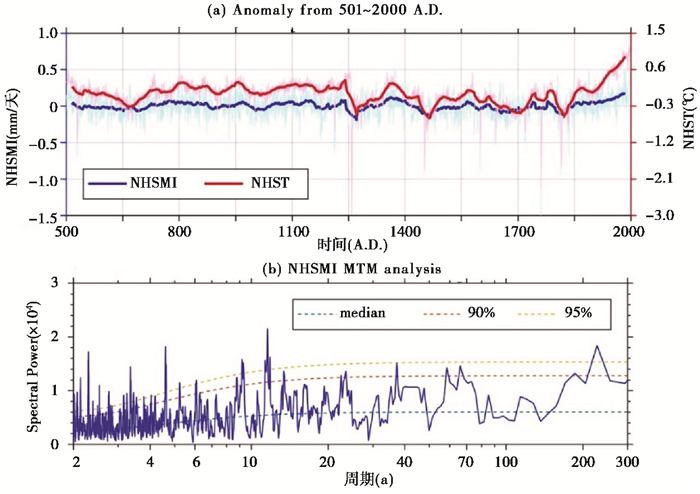
|
图 2 (a) 过去1500年北半球夏季风降水指数距平(NHSMI,淡蓝色为年际变化,蓝色粗线为31年滑动结果,单位:mm/天)和北半球夏季风平均地表气温距平变化(NHST,淡红色为年际变化,红色粗线为31年滑动结果,单位:℃);(b)北半球夏季风降水指数的多窗谱分析 距平序列相对于501~2000年平均,其中北半球夏季风降水指数距平值为5.5 mm/天,北半球夏季平均地表气温距平值为17.8 ℃ Fig. 2 (a)Northern hemisphere summer monsoon rainfall index(NHSMI, light-blue for annual variation and blue for 31-yr running mean variation. The average NHSMI in the past 1500 years is about 5.5 mm/day. Units: mm/day)and Northern hemisphere surface temperature(NHST)anomaly from average of 501~2000 years(light-red for annual variation and blue for 31-yr running mean variation. The average NHST in the past 1500 years is about 17.8 ℃. Units:℃); (b)Power spectra of the NHSMI over the past 1500 years |
图 3为对过去1500年NHSMI序列进行EEMD分解所得到的不同时间尺度IMFs特征向量,通过对各个IMFs的平均周期进行计算可以看出(表 1),C1和C2向量为NHSMI的年际变化,C3~C6向量为NHSMI的年代-多年代际尺度变化,C7~C9向量为NHSMI的百年际尺度变化,R则为残差项,即过去1500年NHSMI的非线性趋势。通过对IMFs进行白噪音检验可以发现[54],C1、C5、C7和C9可达到90 %的置信度,说明通过EEMD分解出来的这几个时间尺度变化特征是有显著意义的,且这几个IMFs亦分别对应于前文的谱分析结果(图 2b),即C1对于显著的年际尺度周期信号(约2~6年),C5对应显著的年代-多年代际尺度周期信号(约58年和66年),C7和C9对应显著的百年际尺度周期信号(约186年、227年和341年)。这些特征也从侧面反应了EEMD方法能有效地提取不同时间尺度上的信号特征。
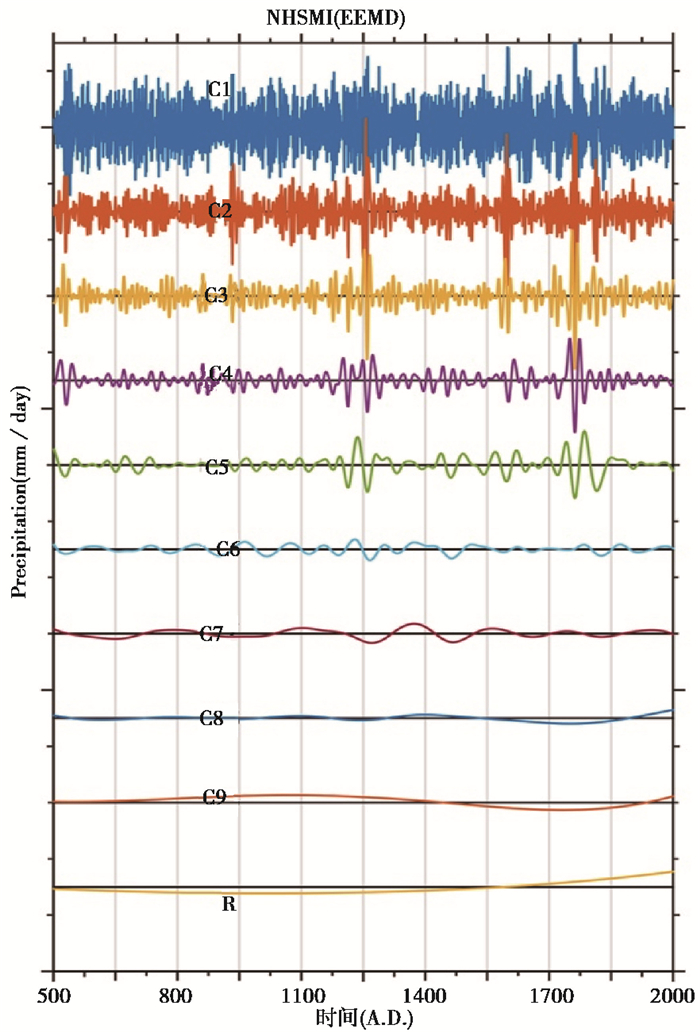
|
图 3 过去1500年北半球夏季风降水指数的EEMD分解 Fig. 3 Northern Hemisphere summer monsoon rainfall index variations at different timescales decomposed by the EEMD method of the past 1500 years |
| 表 1 EEMD分解的过去1500年北半球夏季风指数的固有模态函数分量(IMFs)的平均周期 Table 1 Average periods of the IMFs of the NHSMI based on the EEMD of the past 1500 years(Asterisk indicates significance at the 90 % level of confidence) |
为了得到不同时间尺度下的NHSM降水空间分布特征,利用EEMD分解出来通过显著性检验的IMFs(其中年际变化特征为C1向量;多年代际变化特征为C5向量;百年际变化特征为C7+C9向量)回归到过去1500年NHSM区域降水场,得到不同时间尺度下NHSM的空间变化特征[26]。由图 4可以看出,在年际尺度上(图 4a),热带季风区域的降水对这一信号特征有显著贡献(达到90 %的置信度),即大部分印度半岛、孟加拉湾地区、西北太平洋季风区、北美季风区以及北非季风区,都表现出了显著的年际变化特征(达到90 %的置信度);而在印度季风区的西南部和青藏高原的南部部分区域、北美季风区的南部以及东亚季风区的北部则表现出了与NHSMI年际信号的负相关作用。东亚季风区的年际变化特征,在其北部对北半球夏季风系统的年际尺度信号的贡献较小,亦说明东亚夏季风系统的复杂性。
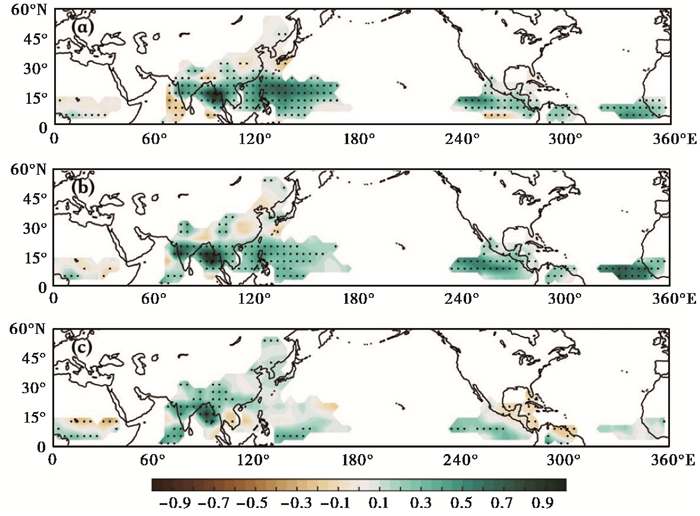
|
图 4 过去1500年北半球夏季风指数的年际(a)、多年代际(b)和百年际(c)周期信号(详见正文)回归的北半球夏季风降水空间分布(数据经过标准化处理) Fig. 4 The NHSMI-regressed summer precipitation distributions at annual (a), decadal (b) and centennial (c) over the past 1500 years(The data are all normalized by the individual standard deviation) |
在多年代际时间尺度上(图 4b),北半球热带季风区域的降水都对NHSMI的多年代际季风变化有显著的贡献(达到90 %的置信度),说明热带季风区降水的多年代际变化特征可能具有相同的影响因素。而在长江以北的大部分东亚季风区域和北非季风的东部区域,对NHSMI的年代-多年代际时间尺度信号的贡献较小。
在百年际尺度上(图 4c),北半球季风区降水基本上对NHSMI的百年际信号都有显著的贡献(达到90 %的置信度),特别是在热带区域的亚洲季风区、西北太平洋季风区的南部、北美季风区的西部以及北非季风区的东部,都表现出了显著的百年际变化特征。此外,在东亚季风区的北部部分区域,也表现出了显著的百年际变化信号特征。
综上所述,在年际、多年代际和百年际时间尺度上,热带季风区的降水变化对各个时间尺度上NHSMI信号的贡献较大,而对东亚季风区的北部,即江淮流域以北的大部分季风区域,贡献较小。那么影响不同NHSMI时间尺度信号的北半球季风区降水分布型态的原因如何?
4 不同时间尺度下NHSM降水分布型态的影响机制讨论 4.1 年际特征通过对NHSMI进行谱分析可以发现(图 2b),其年际尺度上存在显著的2~8年的周期信号特征(达到90 %的置信度),这与ENSO的不规则周期特征(约2~7年)较为相近。多数研究认为ENSO的年际周期变化对北半球夏季风降水年际变率的影响较大[5]:ENSO事件通过改变热带太平洋SST异常来调节Walker环流的强度,水汽向印度-太平洋暖池区域的聚集致使赤道印度洋区域的大气垂直运动异常[55~56],这也影响印度夏季风区域的经向Hadley环流异常[57]。ENSO事件的强度同时也调节了ITCZ的位置,致使西非夏季风与印度夏季风产生年际变化的遥相关作用[7, 58]。此外,影响北美夏季风年际变率的海-陆温度差异亦与ENSO事件有关[59]。但对东亚季风区域而言,其降水的年际变率主要表现在长江中下游流域或江淮流域以南区域[60~61],这可能和影响东亚夏季风区域降水因素的多样且复杂有关[62]。总之,北半球夏季风强度的年际周期特征与ENSO事件密不可分。
由图 5可见,北半球夏季风强度的年际周期特征亦与ENSO模态有较大的关系,即在赤道东太平洋SST显著降温,而在西太平洋区域SST则升温明显,SST的异常致使Walker环流加强,即850 hPa高度的赤道东风加强,水汽在赤道西太平洋区域聚集,引起其纬向上的Hadley环流加强,低层气流向北输送,即为西北太平洋区域季风带来较多水汽输送;在热带印度洋区域,SST减弱而导致了海洋自身蒸发量减少,所以在热带海洋区域印度夏季风降水呈现与年际尺度NHSM强度相反的信号特征,但由于海洋与陆地热容量差异而导致的海陆温差加大,海陆风的加强使得15°N左右的印度夏季风降水增多。前人研究表明,印度夏季风降水的变化和印度洋SST变化有直接关系,而印度洋区域SST的变化很可能受北太平洋ENSO型态的调制作用[63];在北美和北非季风区,由于当前处于类-拉尼娜模态(图 5),赤道东太平洋SST变冷,致使ITCZ带北移,导致北美季风区和北非季风区西部降水增强。与此同时,夏季赤道东太平洋变冷也增大了海陆温差,来自海洋的暖湿气流可输送至墨西哥湾一带,这与前人研究结果较为一致[64];而在东亚季风区,夏季风降水表现出南北区域偶极子模态,这与学者们提出的东亚夏季风降水存在东亚区域南、北反相位变化相一致[65~66]。从SST和850 hPa风场的回归场可以发现(图 5),虽然海陆温差导致印度洋向北的水汽输送加强,但由于副热带高压带北进和西伸较强,低层向西气流阻滞了来自印度洋的水汽输送,致使东亚副热带区域降水增加,海陆温差依然是影响东亚陆地降水的主要原因。但在时间变化上,北半球夏季风强度的年际尺度信号(C1向量)与nino3指数(5°S~5°N,150°W~90°W区域SST的平均值)呈现弱相关性(C1向量与nino3指数的相关系数为0.18,有效自由度约为824.5,P < 0.01)。综上所述,利用CESM模拟的北半球夏季风的年际尺度特征与观测资料结果较为一致[67],ENSO的SST模态是影响其年际降水空间分布的主要因素之一。
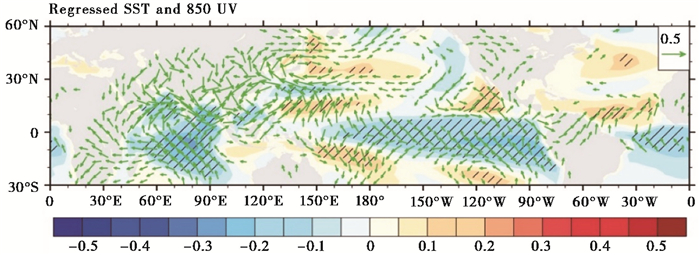
|
图 5 北半球夏季风指数年际信号回归的海表温度(SST)和850 hPa风场(数据经过标准化处理) 850 UV是850 hPa位势高度的风场变化,UV分别为U-Wind和V-Wind Fig. 5 The annual NHSMI-regressed SST and wind field at 850 hPa(The data are all normalized by the individual standard deviation). The 850 UV is the wind field at 850 hPa potental height, where U and V represent the U-wind and V-wind, respectively |
NHSM降水的空间分布对多年代际信号的响应在热带及副热带季风区域较为一致(图 4b),说明其可能具有相同的影响机制。通过对C5向量回归的SST场和850 hPa风场可以看出(图 6),影响多年际NHSM降水的SST场表现为一致增温的现象。有研究表明[26],外强迫是影响NHSM降水多年代际变化特征的主要原因之一,这可能是多年代际时间尺度信号(C5)回归的SST场一致增暖的主要原因(图 6a)。此外,外强迫因子的影响可能放大了多年代际热带太平洋SST的纬向温度梯度,即在西太平洋暖池区域增温幅度较大[68],致使区域经向环流加强[69],从而导致西北太平洋季风区和东亚季风区南部夏季风降水的多年代际特征显著增强(图 6a)。此外,南、北半球温差加大,导致越赤道气流加强(图 6a),向北的暖湿气流给北半球季风区带来更多降水,这也是影响多年代际北半球夏季风强度的原因之一。有研究表明[70],人类活动影响可以加剧南、北半球的温度差异。同样,太阳辐射强度的变化亦会导致南、北半球的温度差异,特别是西太平洋暖池区域SST变化[68],对局地气流和水汽输送都有所影响,说明外强迫因子是影响NHSM多年代际降水空间分布特征的主要原因之一。但是,通过C5向量回归到过去1500年去除趋势影响的SST场可以发现(图 6b),南、北半球的SST依然表现出了显著的温度差异,即北半球SST增加,而南半球SST降低的现象,说明气候系统内部变率亦是控制多年代际北半球夏季风强度的主要因素。另外,有研究表明AMO是影响NHSM多年代际变化的主要原因之一[17]。本文同样发现AMO(0°~60°N,80°W~ 0°区域SST的平均值,数据去除全球SST变化趋势且经过21年滑动平均)与NHSMI的多年代际变化(C5向量)有显著相关性(相关系数为0.48,有效自由度约为71.4,P < 0.01)。
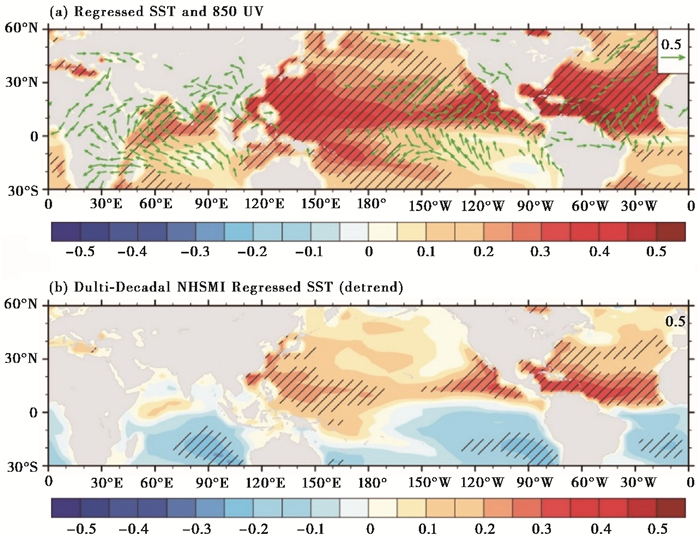
|
图 6 多年代际北半球夏季风指数回归的海表温度(SST)和850 hPa风场(a)以及去趋势海表温度场(b)(数据经过标准化处理) Fig. 6 The multi-decadal NHSMI-regressed SST and wind at 850 hPa (a) and detrend SST (b). The data are all normalized by the individual standard deviation |
总之,北半球夏季风降水的多年代际变化为外强迫因子和气候系统内部变率共同作用所致。其导致南、北半球SST差异(图 6),致使越赤道气流加强,即ITCZ北推,印度、北美以及西非季风区域的多年代际信号显著加强(如图 4b所示)。而在东亚季风区,同样表现为季风区域南、北反相变化,这与前人研究成果较为一致[66]。从回归的850 hPa环流场可以看出(图 6a),南亚高压中心南移至35°N附近,低层偏南气流加强,南下至20°N附近,与来自南北半球经由印度洋的北上气流相持,而导致此区域降水增加,在此以北区域则降水减少。
4.3 百年际特征北半球夏季风降水的百年际尺度变化特征与NHST变化表现出了明显的一致性变化(图 4c),说明外强迫是影响百年际尺度变化的主要原因之一。此外,C7向量表现出的准200年周期也与太阳活动的“苏斯周期”相对应,EEMD百年际分量(C7+C9)与太阳辐射外强迫变化亦具有较高相关性(相关系数为0.79,有效自由度约为30.0,P < 0.01)。其中,中世纪暖期(Medieval Warm Period,简称为MWP)、小冰期(Little Ice Age,简称LIA)和现代暖期(Present Warm Period,简称PWP)对NHSM降水强度影响较大,其在特征时段主要受到外强迫因子的调控作用[71]。由图 7a可以看出,百年际尺度NHSMI回归出的SST场表现为全球一致增暖特征,这亦表明了外强迫因子对北半球夏季风降水百年际信号特征的影响。此外,由于北半球平均温度在现代暖期和小冰期表现为较大变幅,其可以检测出显著的外强迫因子信号,因此利用现代暖期与小冰期的SST场差值可表征在百年尺度上外强迫影响下全球SST场的主要分布特征。如图 7b所示,其SST差异与回归场具有相似的空间分布特征(空间相关性0.93,有效自由度约为22.1,P < 0.01),说明外强迫条件的变化可能是影响过去1500年北半球夏季风百年际变化特征的主要原因。这与Liu等[27]模拟结果相一致。此外,气候代用资料所表现出的亚洲[72]、北非及北美[73]夏季风降水变化亦有此特征,并认为这与太阳辐射变化的关系较为密切。
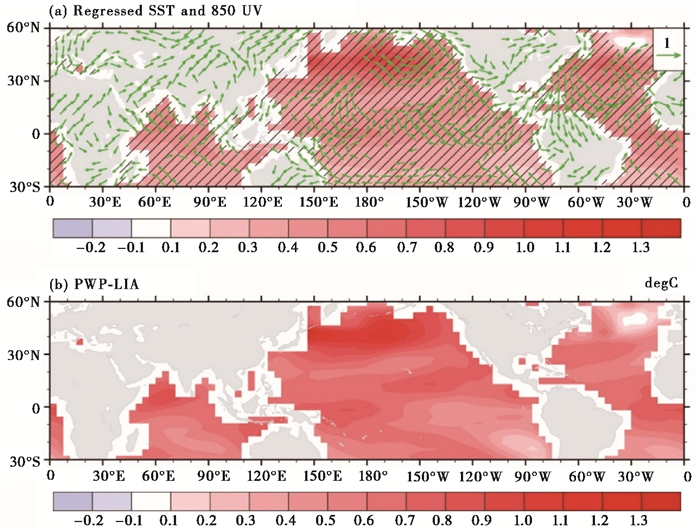
|
图 7 (a) 北半球夏季风指数百年际信号回归的海表温度(SST)和850 hPa风场(数据经过标准化处理);(b)现代暖期(1900~2000 A.D.)与小冰期(1650~1750 A.D.)SST差异 Fig. 7 (a)The centennial NHSMI-regressed SST and wind at 850 hPa(The data are all normalized by the individual standard deviation); (b)The SST difference between the Present Warm Period(1900~2000 A.D.)and Little Ice Age(1650~1750 A.D.) |
不同时间尺度上的北半球夏季风降水变率是衡量水汽循环的重要指标。回到本文最开始的两个问题:过去2000年北半球夏季风系统作为一个整体到底存在哪些周期?不同时间尺度影响下的北半球夏季风降水的空间分布特征以及可能影响机制如何?为了回答这些问题,本文利用通用地球系统模式CESM,在轨道参数、太阳辐射、温室气体、火山活动和土地利用/土地覆盖的强迫下进行了长达2000年的瞬变积分模拟试验。在前人研究基础上,利用北半球夏季风指数来表征北半球夏季风系统强度,探讨了过去1500年来北半球夏季风指数的周期性;提取其不同时间尺度上变化特征,通过回归分析的方法探讨其在不同尺度影响下的NHSM降水分布特征;利用海气相互作用定性地探讨了可能影响机制,结论如下:
(1) 北半球夏季风强度存在显著的年际(约2~6年和8~9年)、年际-多年代际(约11~13年、22~23年、37年、58年和66年)和百年际(186年、227年和341年)的周期波动。
(2) 年际尺度上,北半球夏季风降水对其年际尺度信号的响应在印度半岛、孟加拉湾地区、西北太平洋季风区、北美季风区以及北非季风区表现较为一致,而在印度季风区的西南部和青藏高原的南部区域、北美季风区的南部以及东亚季风区的北部则表现出了相反的信号,在东亚季风区北部其响应特征并不显著。ENSO模态可能是影响年际尺度北半球夏季风降水分配的主要原因。
(3) 在多年代际尺度上,北半球夏季风降水在热带季风区对其响应较为显著且呈一致性变化,而在东亚季风区的北部,即江淮流域以北的大部分季风区域,其降水变化对北半球夏季风多年代际信号的响应并不敏感。主要原因是南、北半球海表温度的空间分布差异致使ITCZ北移,而且这种温度差异是由气候系统内部及外强迫因子共同造成的。
(4) 在百年际尺度上,北半球夏季风区域降水的响应状况基本上表现出与其强度一致的变化特征,其主要是由于外强迫因子变化所导致的。
最后,本文主要使用单个模式CESM进行试验和结果分析,可能存在模式依赖性,所以更多的长时间模拟结果需要加入进来对本文的结论进行验证。另外,由于时间和机时的关系,本研究仅进行了一条全强迫模拟试验结果,所以可能存在强迫初值对模拟结果的影响,未来需要更多的强迫试验结果进行集合平均,以消除这种影响。但是本文仍然能为全球季风系统的研究贡献一定的参考价值。此外,本研究对不同时间尺度特征影响下的北半球夏季风降水分布的机理分析尚浅,特别是其多年代际尺度信号的影响,到底为气候系统内部变率还是外强迫因子的影响?亦或是如何区分北半球夏季风降水对它们的响应?百年际尺度特征虽然主要为外强迫因子的影响,但各个外强迫因子的贡献如何?以及是否能进行定量化区分?这些问题有理由成为进一步研究全球季风系统所关注的重点。
致谢: 靳春寒对数据的提取;宁亮、刘飞在讨论中提供很大的帮助;审稿老师提出了非常有用的建设性意见,一并致以诚挚的谢意。
| [1] |
Masson-Delmotte V, Schulz M, Abe-Ouchi A, et al. Information from paleoclimate archives[M]//Stocker T F, Qin D, Plattner G-K, et al. Climate Change 2013: The Physical Science Basis. Contribution of Working Group Ⅰ to the Fifth Assessment Report of the Intergovernmental Panel on Climate Change. Cambridge: Cambridge University Press, 2013: 383~464.
|
| [2] |
Trenberth K E, Stepaniak D P, Caron J M. The global monsoon as seen through the divergent atmospheric circulation[J]. Journal of Climate, 2000, 13(22): 3969-3993. DOI:10.1175/1520-0442(2000)013<3969:TGMAST>2.0.CO;2 |
| [3] |
Qian W. Dry/wet alternation and global monsoon[J]. Geophysical Research Letters, 2000, 27(22): 3679-3682. DOI:10.1029/1999GL011255 |
| [4] |
Qian W, Deng Y, Zhu Y, et al. Demarcating the worldwide monsoon[J]. Theoretical and Applied Climatology, 2002, 71(1-2): 1-16. DOI:10.1007/s704-002-8204-0 |
| [5] |
Wang B, Ding Q. Global monsoon:Dominant mode of annual variation in the tropics[J]. Dynamics of Atmospheres and Oceans, 2008, 44(3-4): 165-183. DOI:10.1016/j.dynatmoce.2007.05.002 |
| [6] |
Chase T N, Knaff J A, Pielke R A, et al. Changes in global monsoon circulations since 1950[J]. Natural Hazards, 2003, 29(2): 229-254. DOI:10.1023/A:1023638030885 |
| [7] |
Schneider T, Bischoff T, Haug G H. Migrations and dynamics of the intertropical convergence zone[J]. Nature, 2014, 513(7516): 45-53. DOI:10.1038/nature13636 |
| [8] |
Cheng H, Edwards R L, Broecker W S, et al. Ice age terminations[J]. Science, 2009, 326(5950): 248-252. DOI:10.1126/science.1177840 |
| [9] |
Kim H J, Wang B, Ding Q. The global monsoon variability simulated by CMIP 3 Coupled Climate Models[J]. Journal of Climate, 2008, 21(20): 5271-5294. DOI:10.1175/2008JCLI2041.1 |
| [10] |
Crowley T J, Zielinski G, Vinther B, et al. Volcanism and the Little Ice Age[J]. PAGES Newsletter, 2008, 16: 22-23. DOI:10.22498/pages.16.2 |
| [11] |
Robock A. Volcanic eruptions and climate[J]. Reviews of Geophysics, 2000, 38(2): 191-219. DOI:10.1029/1998RG000054 |
| [12] |
Liu F, Chai J, Wang B, et al. Global monsoon precipitation responses to large volcanic eruptions[J]. Scientific Reports, 2016, 6. DOI:10.1038/srep24331 |
| [13] |
Stevenson S, Fasullo J T, Otto-Bliesner B L, et al. Role of eruption season in reconciling model and proxy responses to tropical volcanism[J]. Proceedings of the National Academy of Sciences of the United States of America, 2017, 114: 1822-1826. DOI:10.1073/pnas.1612505114 |
| [14] |
Wang B, Ding Q. Changes in global monsoon precipitation over the past 56 years[J]. Geophysical Research Letters, 2006, 33(6): 1-4. |
| [15] |
Wang B, Liu J, Kim H J, et al. Recent change of the global monsoon precipitation(1979-2008)[J]. Climate Dynamics, 2012, 39(5): 1123-1135. DOI:10.1007/s00382-011-1266-z |
| [16] |
Okumura Y M, Sun T, Wu X. Asymmetric modulation of El Niño and La Niña and the linkage to tropical Pacific decadal variability[J]. Journal of Climate, 2017, 30(12): 4705-4733. DOI:10.1175/JCLI-D-16-0680.1 |
| [17] |
Wang B, Liu J, Kim H J, et al. Northern Hemisphere summer monsoon intensified by mega-El Niño/Southern Oscillation and Atlantic multidecadal oscillation[J]. Proceedings of the National Academy of Sciences of the United States of America, 2013, 110(14): 5347-5352. DOI:10.1073/pnas.1219405110 |
| [18] |
Xie S P, Lu B, Xiang B. Similar spatial patterns of climate responses to aerosol and greenhouse gas changes[J]. Nature Geoscience, 2013, 6(10): 828. DOI:10.1038/ngeo1931 |
| [19] |
Liu J, Rühland K M, Chen J, et al. Aerosol-weakened summer monsoons decrease lake fertilization on the Chinese Loess Plateau[J]. Nature Climate Change, 2017, 7: 190-194. DOI:10.1038/nclimate3220 |
| [20] |
Wilcox L J, Highwood E J, Dunstone N J. The influence of anthropogenic aerosol on multi-decadal variations of historical global climate[J]. Environmental Research Letters, 2013, 8(2). DOI:10.1088/1748-9326/8/2/024033 |
| [21] |
史锋, 杨保, 赵森, 等. 全球过去千年典型暖期温度空间格局重建[J]. 第四纪研究, 2014, 34(6): 1125-1135. Shi Feng, Yang Bao, Zhao Sen, et al. Spatial pattern reconstruction of typical centennial warm periods of global temperature over the past millennium[J]. Quaternary Sciences, 2014, 34(6): 1125-1135. |
| [22] |
史锋, 杨保, 冯娟, 等. 利用树轮资料集成重建的过去2000年北半球年平均温度变化[J]. 第四纪研究, 2015, 35(5): 1051-1063. Shi Feng, Yang Bao, Feng Juan, et al. Reconstruction of the Northern Hemisohere annual temperature change over the Common Era derived from tree rings[J]. Quaternary Sciences, 2015, 35(5): 1051-1063. |
| [23] |
杨保, 王鑫, 宋苗, 等. 过去2000年温度集成重建研究:进展与展望[J]. 第四纪研究, 2017, 37(5): 945-962. Yang Bao, Wang Xin, Song Miao, et al. Temperature reconstructions of last millennium and common era climate variations:Present status and future prospects[J]. Quaternary Sciences, 2017, 37(5): 945-962. |
| [24] |
PAGES K C. Continental-scale temperature variability during the past two millennia[J]. Nature Geoscience, 2013, 6(5): 339-346. DOI:10.1038/ngeo1797 |
| [25] |
Liu J, Chen S, Chen J, et al. Chinese cave δ18O records do not represent northern East Asian summer monsoon rainfall[J]. Proceedings of the National Academy of Sciences of the United States of America, 2017, 114(15): E2987-E2988. DOI:10.1073/pnas.1703471114 |
| [26] |
Liu J, Wang B, Yim S Y, et al. What drives the global summer monsoon over the past millennium?[J]. Climate Dynamics, 2012, 39: 1063-1072. DOI:10.1007/s00382-012-1360-x |
| [27] |
Liu J, Wang B, Ding Q, et al. Centennial variations of the global monsoon precipitation in the last millennium:Results from ECHO-G model[J]. Journal of Climate, 2009, 22(9): 2356-2371. DOI:10.1175/2008JCLI2353.1 |
| [28] |
Man W, Zhou T, Jungclaus J H. Simulation of the East Asian summer monsoon during the last millennium with the MPI Earth System Model[J]. Journal of Climate, 2012, 25(22): 7852-7866. DOI:10.1175/JCLI-D-11-00462.1 |
| [29] |
Fasullo J. A mechanism for land-ocean contrasts in global monsoon trends in a warming climate[J]. Climate Dynamics, 2012, 39(5): 1137-1147. DOI:10.1007/s00382-011-1270-3 |
| [30] |
张诗茄, 刘健, 王志远, 等.过去1500年典型暖期北半球季风降水的变化特征及其差异对比[EB/OL].北京: 中国科技论文在线, 2017, 2(2): http://www.paper.edu.cn/releasepaper/content/201702-6. Zhang Shijia, Liu Jian, Wang Zhiyuan, et al. A comparison of characteristics and attribution of the Northern Hemisphere summer monsoon during the typical war periods over the past 1500 years[EB/OL]. Beijing: Science Paper Online, 2017, 2(2): http://www.paper.edu.cn/releasepaper/content/201702-6. |
| [31] |
Lee J Y, Wang B. Future change of global monsoon in the CMIP 5[J]. Climate Dynamics, 2014, 42(1-2): 101-119. DOI:10.1007/s00382-012-1564-0 |
| [32] |
Otto-Bliesner B L, Brady E C, Fasullo J, et al. Climate variability and change since 850 CE:An ensemble approach with the community Earth SystemModel[J]. Bulletin of the American Meteorological Society, 2016, 97(5): 735-754. DOI:10.1175/BAMS-D-14-00233.1 |
| [33] |
Marsh D R, Mills M J, Kinnison D E, et al. Climate change from 1850 to 2005 simulated in CESM 1(WACCM)[J]. Journal of Climate, 2013, 26(19): 7372-7391. DOI:10.1175/JCLI-D-12-00558.1 |
| [34] |
Vizcaíno M, Lipscomb W H, Sacks W J, et al. Greenland surface mass balance as simulated by the community earth system model. Part Ⅱ:Twenty-first-century changes[J]. Journal of Climate, 2014, 27(1): 215-226. DOI:10.1175/JCLI-D-12-00588.1 |
| [35] |
Sooraj K P, Terray P, Mujumdar M. Global warming and the weakening of the Asian summer monsoon circulation:Assessments from the CMIP 5 models[J]. Climate Dynamics, 2015, 45(1-2): 233-252. DOI:10.1007/s00382-014-2257-7 |
| [36] |
王志远, 刘健, 王晓青, 等. 地球系统模式CESM 1.0对太阳辐射和温室气体的敏感性差异研究[J]. 第四纪研究, 2016, 36(3): 758-767. Wang Zhiyuan, Liu Jian, Wang Xiaoqing, et al. Divergent sensitivity of Earth System Model CESM 1.0 to solar radiation versus greenhouse gases[J]. Quaternary Sciences, 2016, 36(3): 758-767. |
| [37] |
王志远, 刘健. 过去2000年全球典型暖期特征与机制的模拟研究[J]. 第四纪研究, 2014, 34(6): 1136-1145. Wang Zhiyuan, Liu Jian. Modeling study on the characteristics and mechanisms of global typical warm periods over the past 2000 years[J]. Quaternary Sciences, 2014, 34(6): 1136-1145. |
| [38] |
Berger A L. Long-term variations of daily insolation and Quaternary climatic changes[J]. Journal of Meteorology, 1978, 35: 2362-2367. |
| [39] |
Shapiro A I, Schmutz W, Rozanov E, et al. A new approach to the long-term reconstruction of the solar irradiance leads to large historical solar forcing[J]. Astronomy & Astrophysics, 2011, 529. DOI:10.1051/0004-6361/201016173 |
| [40] |
Gao C, Robock A, Ammann C. Volcanic forcing of climate over the past 1500 years:An improved ice core-based index for climate models[J]. Journal of Geophysical Research:Atmospheres, 2008, 113(D23): 1-15. |
| [41] |
MacFarling Meure C, Etheridge D, Trudinger C, et al. Law Dome CO2, CH4 and N2O ice core records extended to 2000 years BP[J]. Geophysical Research Letters, 2006, 33(14): 1-4. |
| [42] |
Kaplan J O, Krumhardt K M, Ellis E C, et al. Holocene carbon emissions as a result of anthropogenic land cover change[J]. The Holocene, 2011, 21(5): 775-791. DOI:10.1177/0959683610386983 |
| [43] |
Wang Z, Li Y, Liu B, et al. Global climate internal variability in a 2000-year control simulation with Community Earth System Model(CESM)[J]. Chinese Geographical Science, 2015, 25(3): 263-273. DOI:10.1007/s11769-015-0754-1 |
| [44] |
严蜜, 王志远, 刘健. 中国过去1500年典型暖期气候的模拟研究[J]. 第四纪研究, 2015, 34(6): 1166-1175. Wang Xiaoqing, Liu Jian, Wang Zhiyuan. Comparison of simulated and reconstructed temperature in China during the past 2000 years[J]. Advances in Earth Science, 2015, 34(12): 1318-1327. |
| [45] |
王晓青, 刘健, 王志远. 过去2000年中国区域温度模拟与重建的对比分析[J]. 地球科学进展, 2014, 34(12): 1318-1327. Yan Mi, Wang Zhiyuan, Liu Jian. Simulation of the characteristics and mechanisms of Chinese typical warm periods over the past 1500 years[J]. Quaternary Sciences, 2014, 34(6): 1166-1175. |
| [46] |
靳春寒, 刘健, 王志远. 中国中世纪暖期温度年代际变化特征及成因分析[J]. 第四纪研究, 2016, 36(4): 970-982. Jin Chunhan, Liu Jian, Wang Zhiyuan. Study on the characteristics and causes of interdecadal temperature changes in China during the MWP[J]. Quaternary Sciences, 2016, 36(4): 970-982. |
| [47] |
孙炜毅, 刘健, 王志远. 东亚冬季风百年尺度变化特征及成因的模拟研究[J]. 第四纪研究, 2016, 36(3): 722-731. Sun Weiyi, Liu Jian, Wang Zhiyuan. Modeling study on the characteristics and causes of East Asian winter monsoon on centennial time scale[J]. Quaternary Sciences, 2016, 36(3): 722-731. |
| [48] |
韩春凤, 刘健, 王志远. 过去2000年亚洲夏季风降水百年尺度变化及其区域差异的模拟分析[J]. 第四纪研究, 2016, 36(3): 732-746. Han Chunfeng, Liu Jian, Wang Zhiyuan. Simulated analysis of Asian summer monsoon precipitation on centennial time scale and its regional differences over the past 2000 years[J]. Quaternary Sciences, 2016, 36(3): 732-746. |
| [49] |
Huang N E, Wu Z. A review on Hilbert-Huang transform:Method and its applications to geophysical studies[J]. Reviews of Geophysics, 2008, 46(2). DOI:10.1029/2007RG000228 |
| [50] |
Wu Z, Huang N E. Ensemble empirical mode decomposition:A noise-assisted data analysis method[J]. Advances in Adaptive Data Analysis, 2009, 1(1): 1-41. |
| [51] |
Ji F, Wu Z, Huang J, et al. Evolution of land surface air temperature trend[J]. Nature Climate Change, 2014, 4(6): 462-466. DOI:10.1038/nclimate2223 |
| [52] |
牛震敏, 杨凤梅, 王乃昂, 等. 巴颜喀拉山东端过去376年来夏季气温变化[J]. 第四纪研究, 2016, 36(4): 983-992. Niu Zhenmin, Yang Fengmei, Wang Nai'ang, et al. Summer temperature variability for eastern Bayan Har Mountains over the past 376 years[J]. Quaternary Sciences, 2016, 36(4): 983-992. |
| [53] |
张志平, 黄伟, 陈建徽, 等. 全新世东亚夏季风演化的多尺度周期变化及其可能机制探讨[J]. 第四纪研究, 2017, 37(3): 498-509. Zhang Zhiping, Huang Wei, Chen Jianhui, et al. Multi-time scale analysis of East Asian summer monsoon and its possible mechanism during Holocene[J]. Quaternary Sciences, 2017, 37(3): 498-509. |
| [54] |
Wu Z, Huang N E. Statistical significance test of intrinsic mode functions[J]. Hilbert-Huang Transform and Its Applications, 2005, 5: 107-127. DOI:10.1142/IMS |
| [55] |
Kumar K K, Rajagopalan B, Hoerling M, et al. Unraveling the mystery of Indian monsoon failure during El Niño[J]. Science, 2006, 314(5796): 115-119. DOI:10.1126/science.1131152 |
| [56] |
Kumar K K, Rajagopalan B, Cane M A. On the weakening relationship between the Indian monsoon and ENSO[J]. Science, 1999, 284(5423): 2156-2159. DOI:10.1126/science.284.5423.2156 |
| [57] |
Krishnamurthy V, Goswami B N. Indian monsoon-ENSO relationship on interdecadal timescale[J]. Journal of Climate, 2000, 13(3): 579-595. DOI:10.1175/1520-0442(2000)013<0579:IMEROI>2.0.CO;2 |
| [58] |
Raicich F, Pinardi N, Navarra A. Teleconnections between Indian monsoon and Sahel rainfall and the Mediterranean[J]. International Journal of Climatology, 2003, 23(2): 173-186. DOI:10.1002/(ISSN)1097-0088 |
| [59] |
Higgins R W, Mo K C, Yao Y. Interannual variability of the US summer precipitation regime with emphasis on the southwestern monsoon[J]. Journal of Climate, 1998, 11(10): 2582-2606. DOI:10.1175/1520-0442(1998)011<2582:IVOTUS>2.0.CO;2 |
| [60] |
Nan S, Li J. The relationship between the summer precipitation in the Yangtze River valley and the boreal spring Southern Hemisphere annular mode[J]. Geophysical Research Letters, 2003, 30(24). DOI:10.1029/2003GL018381 |
| [61] |
Wang B, Wu R, Lau K M. Interannual variability of the Asian summer monsoon:Contrasts between the Indian and the western North Pacific-East Asian monsoons[J]. Journal of Climate, 2001, 14(20): 4073-4090. DOI:10.1175/1520-0442(2001)014<4073:IVOTAS>2.0.CO;2 |
| [62] |
Ding Y H, Johnny C C L. The East Asian summer monsoon:An overview[J]. Meteorology and Atmospheric Physics, 2005, 89(1): 117-142. |
| [63] |
Dong L, Zhou T J, Dai A G, et al. The footprint of the inter-decadal Pacific Oscillation in Indian Ocean sea surface temperatures[J]. Scientific Reports, 2016, 6(1): 21251. DOI:10.1038/srep21251 |
| [64] |
Boening C, Willis J K, Landerer F W, et al. The 2011 La Niña:So strong, the oceans fell[J]. Geophysical Research Letters, 2011, 39(19). DOI:10.1029/2012GL053055 |
| [65] |
Chen F H, Xu Q H, Chen J H, et al. East Asian summer monsoon precipitation variability since the last deglaciation[J]. Scientific Reports, 2015, 5(1): 11186. DOI:10.1038/srep11186 |
| [66] |
Liu J, Wang B, Wang H L, et al. Forced response of the East Asian summer rainfall over the past millennium:Results from a coupled model simulation[J]. Climate Dynamics, 2011, 36(1-2): 323-336. DOI:10.1007/s00382-009-0693-6 |
| [67] |
Wang P X, Wang B, Cheng H, et al. The global monsoon across timescales:Coherent variability of regional monsoons[J]. Climate of the Past, 2014, 10(6): 2007-2052. DOI:10.5194/cp-10-2007-2014 |
| [68] |
Liu J, Wang B, Cane M A, et al. Divergent global precipitation changes induced by natural versus anthropogenic forcing[J]. Nature, 2013, 493(7434): 656-659. DOI:10.1038/nature11784 |
| [69] |
Feng J, Li J P, Xie F. Long-term variation of the principal mode of Boreal Spring Hadley Circulation linked to SST over the Indo-Pacific Warm Pool[J]. Journal of Climate, 2012, 26(2): 532-544. |
| [70] |
Luo J J, Sasaki W, Masumoto Y. Indian Ocean warming modulates Pacific climate change[J]. Proceedings of the National Academy of Sciences of the United States of America, 2012, 109(46): 18701-18706. DOI:10.1073/pnas.1210239109 |
| [71] |
Lamb H H. Climate:Present, Past and Future(Routledge Revivals):Volume 2:Climatic History and the Future[M]. London: Methuen, 1977: 837.
|
| [72] |
Zhang P, Cheng H, Edwards R L, et al. A test of climate, sun, and culture relationships from an 1810-year Chinese cave record[J]. Science, 2008, 322(5903): 940-942. DOI:10.1126/science.1163965 |
| [73] |
Asmerom Y, Polyak V J, Rasmussen J B T, et al. Multidecadal to multicentury scale collapses of Northern Hemisphere monsoons over the past millennium[J]. Proceedings of the National Academy of Sciences of the United States of America, 2013, 110(24): 9651-9656. DOI:10.1073/pnas.1214870110 |
2 Nanjing Star-Jelly Environmental Consultants Co. Ltd., Nanjing 210013, Jiangsu;
3 Key Laboratory of Desert and Desertification, Northwest Institute of Eco-Environment and Resources, Chinese Academy of Sciences, Lanzhou 730000, Gansu;
4 Nanjing Environmental Health Emergency Response Center, Nanjing 210000, Jiangsu;
5 Laboratory of Environmental Change and Palaeoecology, College of Chemistry and Life Sciences, Zhejiang Normal University, Jinhua 321004, Zhejiang;
6 College of Meteorology and Oceanography, National University of Defense Technology, Nanjing 211101, Jiangsu;
7 Key Laboratory for Virtual Geographic Environment, Ministry of Education; State Key Laboratory of Geographical Environmental Evolution, Jiangsu Provincial Cultivation Base; School of Geography Science, Nanjing Normal University, Nanjing 210023, Jiangsu)
Abstract
Northern Hemisphere summer monsoon (NHSM)is one of the most significant components of global monsoon, and the intensity of NHSM can affect food production and security of most people all over the world. Studying the different timescales of NHSM variations over the past 2000 years are not only benefits to understand the system of global monsoon, but also to predict the development of the NHSM and long-term policy-making. However, the most previous research is mainly focused on the NHSM temporal variations at different timescales, the spatial characteristics and mechanisms of NHSM are relatively fewer considered. Here is mainly focused on the following questions:Over the past 2000 years, what are the periodic signals of the NHSM intensity, and what are the spatial characteristics of the NHSM rainfall respond to different timescales?To address these issues, Community Earth System Model (CESM 1.0)is employed to conduct a transient simulation for the last 2000 years, which is forced by the reconstructions of total solar irradiation (TSI), Greenhouse gases (GHGs), volcanic forcing (VOL), land use and land cover (LUCC)and orbital changes. Firstly, the modeling outputs indicate that the simulated Northern Hemisphere summer temperature (NHST)variations show a good coherence with NHSM index over the past 1500 years after 31-yr smoothing. Secondly, ensemble empirical mode decomposition (EEMD)is used to isolate the NHSM index variations on interdecadal to multi-centennial timescales. Then, the NHSM index variations are regressed on the corresponding sea surface temperatures and winds at 850 hPa to elucidate the possible mechanisms for the NHSM patterns at different timescales. The primary conclusions are as follows: (1)The NHSM rainfall exhibits significant periodicities of 2~6 and 8~9 years, multi-decadal periodicities of 11~13, 22~23, 37, 58 and 66 years and centennial periodicities of 186, 227 and 341 years (above 90% confidence level). (2)The NHSM rainfalls are positively consistent with interdecadal timescale in the monsoon regions of Indian, Bay of Bengal, northwest Pacific and North Africa over the past 1500 years, but have negative correlations in monsoon regions of southwest of Indian, southern North America and northern East Asian. A main reason for the distributions of the NHSM rainfall is the cyclical variations of El Niño Southern Oscillation (ENSO). (3)The NHSM rainfalls are associated with multi-decadal timescale over the most tropical regions due to the difference of surface air temperature between the North and South Hemisphere. This difference may be caused by the external and internal forcing. Over the extra tropical regions, such as the East Asian monsoon regions, the NHSM rainfalls are not sensitive to the variations of multi-decadal signals. (4)Over the most of the NHSM regions, the external forcing can affect the large-scale coherence of the precipitation variations response to the NHSM on the centennial to multi-centennial timescales. 2018, Vol.38
2018, Vol.38
